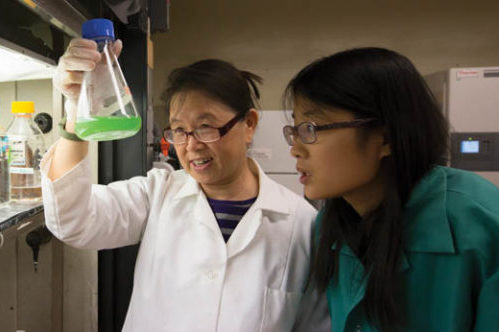Missouri S&T, PCRMC partner on new research
Posted by Andrew Careaga

Dr. Honglan Shi is one Missouri S&T faculty member conducting research through the Ozark Biomedical Initiative. Here, she and a student study drinking water quality in Schrenk Hall. Photo By Sam O’Keefe/Missouri S&T

Dr. Honglan Shi is one Missouri S&T faculty member conducting research through the Ozark Biomedical Initiative. Here, she and a student study drinking water quality in Schrenk Hall. Photo By Sam O’Keefe/Missouri S&T
Researchers from Missouri University of Science and Technology are working with physicians and clinicians from Phelps County Regional Medical Center on medical research that could lead to new treatments for cancer and traumatic brain injury, a new way to predict potential problems at childbirth, and a method to attract and capture poisonous brown recluse spiders.
The research is funded through the Ozark Biomedical Initiative, a partnership between PCRMC and Missouri S&T that provides seed money to support biomedical research. The OBI is an outcome of a partnership between the university and medical center that was formalized in July 2015.
Through the OBI, Missouri S&T and PCRMC each contribute $25,000 annually to fund joint research proposals that involve researchers from both entities. That funding provides seed money for research and testing that can support future proposals to major funding agencies like the National Institutes of Health, says Dr. Warren K. Wray, vice chancellor for Global and Strategic Partnerships at Missouri S&T. Wray and PCRMC president and chief executive officer Edward Clayton co-chair OBI’s executive committee.
OBI recently awarded proposals for its first research projects. OBI’s research and education council, chaired by Dr. Nuran Ercal, the Richard K. Vitek/Foundation for Chemical Research Endowed Chair in Biochemistry at Missouri S&T, awarded grants to the following projects:
- “Characterization of Brown Recluse Spider Sex Pheromones Using Innovative Sampling Techniques,” by Dr. Honglan Shi, research professor of chemistry at Missouri S&T, and Dr. William V. Stoecker, consulting dermatologist at PCRMC. The researchers plan to characterize the sex pheromones of brown recluse spiders to make a better trap for these poisonous spiders. Working with Shi and Stoecker are Casey Burton, a Ph.D. student in chemistry at Missouri S&T, and Jennifer Parks, a technician in biological sciences at Missouri S&T; Casey Burton and Haiting Zhang, Ph.D. students in chemistry at Missouri S&T; Jesse Liu, a student at Rolla High School, and Rhianna Bliss, a student at Borgia High School in Washington, Missouri.
- “Direction-Modulated Immobilized Biodegradable Brachytherapy,” by Dr. Jonghyun Park, assistant professor of mechanical and aerospace engineering at Missouri S&T; Dr. Chang-Soo Kim, professor of electrical and computer engineering at Missouri S&T; and Dr. Chris Spencer, director of radiation oncology at PCRMC. This project involves the fabrication of a biodegradable brachytherapy implant that could deliver concentrated radiation therapy to target cancerous tumors.
- “Power Combos: Antibody Conjugated Drug Nanorods and T Cell Therapy for Breast Cancer Treatment,” by Dr. Sutapa Barua, assistant professor of chemical and biochemical engineering at Missouri S&T, and Dr. Stephen R. Toothaker, attending physician of hematology and oncology at PCRMC’s Delbert Day Cancer Institute. This group proposes developing “nanorods” as vessels to deliver treatments to breast cancer patients. Measured in nanometers, or billionths of a meter, nanorods are thousands of times smaller than a human hair.
- “Development of a High-Performance Liquid Chromatography-Tandem Mass Spectrometry Method for the Simultaneous Determination of 10 Putative Biomarkers for Traumatic Brain Injury in Urine,” by Dr. Yinfa Ma, Curators’ Distinguished Teaching Professor of chemistry at Missouri S&T; Dr. Donald James, chief medical officer at PCRMC; and Casey Burton, a Ph.D. student in chemistry at Missouri S&T. The research involves developing new techniques to detect biomarkers in urine that could indicate whether a person has sustained a traumatic brain injury.
- “Computational Methods for Predicting Fetal Outcomes from Heart Rate Patterns,” by Dr. Steven Corns, associate professor of engineering management and systems engineering at Missouri S&T; Dr. James Davison, attending physician in obstetrics and gynecology at PCRMC; and Pamela Feeler, director of clinical informatics at PCRMC. This team plans to study fetal heart rate patterns to develop a computational model to predict the risk of fetal hypoxia and acidosis after a mother has entered labor.
The researchers will discuss their projects at the upcoming OBI Research Symposium, to be held in August. Also during the symposium, Ercal will complete her term as chair of the OBI research and education council and Stoecker will become chair.
For more information about the Ozark Biomedical Initiative, visit obi.mst.edu.
Leave a Reply